Eleanor Rigby
| "Eleanor Rigby" | ||||||||||||||||||
|---|---|---|---|---|---|---|---|---|---|---|---|---|---|---|---|---|---|---|
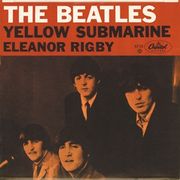 |
||||||||||||||||||
| Single by The Beatles | ||||||||||||||||||
| from the album Revolver | ||||||||||||||||||
| A-side | "Yellow Submarine" | |||||||||||||||||
| Released | 5 August 1966 | |||||||||||||||||
| Format | 7" | |||||||||||||||||
| Recorded | 28–29 April; 6 June 1966 Abbey Road Studios |
|||||||||||||||||
| Genre | Baroque pop | |||||||||||||||||
| Length | 2:06 | |||||||||||||||||
| Label | Parlophone | |||||||||||||||||
| Writer(s) | Lennon/McCartney | |||||||||||||||||
| Producer | George Martin | |||||||||||||||||
| The Beatles singles chronology | ||||||||||||||||||
|
||||||||||||||||||
|
||||||||||||||||||
"Eleanor Rigby" is a song by The Beatles, simultaneously released on the 1966 album Revolver and on a 45rpm single. The song was written by Paul McCartney, but credited to Lennon/McCartney.[1] With a double string quartet arrangement by George Martin, and striking lyrics about loneliness, the song continued the transformation of the group from a mainly pop-oriented act to a more serious and experimental studio band.
Contents |
Inspiration
As with many of McCartney's songs, the melody and first line of the song came to him as he was playing around on his piano. The name that came to him, though, was not Eleanor Rigby but Miss Daisy Hawkins. In 1966, McCartney recalled how he got the idea for his song:
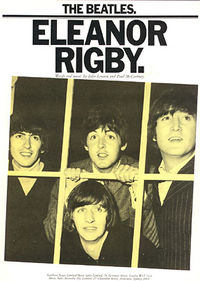
| “ | I was sitting at the piano when I thought of it. The first few bars just came to me, and I got this name in my head... 'Daisy Hawkins picks up the rice in the church'. I don't know why. I couldn't think of much more so I put it away for a day. Then the name Father McCartney came to me, and all the lonely people. But I thought that people would think it was supposed to be about my Dad sitting knitting his socks. Dad's a happy lad. So I went through the telephone book and I got the name McKenzie.[2] | ” |
Others believe that Father McKenzie refers to 'Father' Tommy McKenzie, who was the compere at Northwich Memorial Hall.[3][4]
McCartney said he came up with the name Eleanor from actress Eleanor Bron, who had starred with the Beatles in the film Help!. Rigby came from the name of a store in Bristol, Rigby & Evens Ltd, Wine & Spirit Shippers, that he noticed while seeing his then-girlfriend Jane Asher act in The Happiest Days Of Your Life. He recalled in 1984, "I just liked the name. I was looking for a name that sounded natural. Eleanor Rigby sounded natural."[5]
The Beatles finished the song in the music room of John Lennon's home at Kenwood. John Lennon, George Harrison, Ringo Starr, and their friend Pete Shotton all listened to McCartney play his song through and contributed ideas. Starr contributed the line "writing the words of a sermon that no one will hear " and suggested making "Father McCartney" darn his socks, which McCartney liked. Shotton then suggested that McCartney change the name of the priest, in case listeners mistook the fictional character in the song for McCartney's own father.[6]
The song is often described as a lament for lonely people[7] or a commentary on post-war life in Britain.[8][9]
McCartney couldn't decide how to end the song, and Shotton finally suggested that the two lonely people come together too late as Father McKenzie conducts Eleanor Rigby's funeral. At the time, Lennon rejected the idea out of hand, but McCartney said nothing and used the idea to finish off the song, later acknowledging Shotton's help.[6]
Lennon was quoted in 1972 as having said that he wrote 70% of the lyrics,[10] and in 1980 claimed that he wrote all but the first verse,[11] but Pete Shotton, Lennon's childhood friend, remembered Lennon's contribution as being "absolutely nil".[12] Donovan also reported that he heard McCartney play it to him before it was finished.[13]
Recording
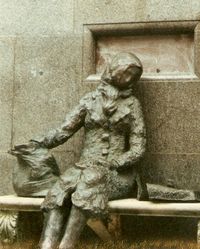
"Eleanor Rigby" does not have a standard pop backing; none of the Beatles played instruments on it, though John Lennon and George Harrison did contribute harmony vocals.[14] Instead, McCartney used a string octet of studio musicians, composed of four violins, two cellos, and two violas, all performing a score composed by producer George Martin.[14] For the most part, the instruments "double up"—that is, they serve as two string quartets with two instruments playing each part in the quartet. Microphones were placed close to the instruments to produce a more vivid and raw sound. George Martin asked musicians to play without vibrato and recorded two versions, one with and one without, the latter of which was used. McCartney's choice of a string backing may have been influenced by his interest in the composer Antonio Vivaldi. Lennon recalled in 1980 that "Eleanor Rigby" was "Paul's baby, and I helped with the education of the child ... The violin backing was Paul's idea. Jane Asher had turned him on to Vivaldi, and it was very good."[15] The octet was recorded on 28 April 1966, in Studio 2 at Abbey Road Studios and completed in Studio 3 on 29 April and on 6 June. Take 15 was selected as the master.[16]
George Martin, in his autobiography All You Need Is Ears, takes credit for combining two of the vocal parts, having noticed that they would work together contrapuntally. He cited the influence of Bernard Herrmann's work, particularly the score for the film Fahrenheit 451, on his string scoring.[17]
The original stereo mix had Paul's voice only in the right channel during the verses, with the string octet mixed to one channel, while the mono single and mono LP featured a more balanced mix. On the Yellow Submarine Songtrack and Love versions, McCartney's voice is centred and the string octet appears in stereo in an attempt to create a more "modern" sounding mix.
Releases
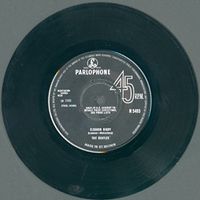
"Eleanor Rigby" was released simultaneously on 5 August 1966 on both the album Revolver and on a double A-side single with "Yellow Submarine" on Parlophone in the United Kingdom and Capitol in the United States.[18] It spent four weeks at number one on the British charts,[14] but in America it only reached the eleventh spot.[19]
The song was nominated for three Grammys and won the 1966 Grammy for Best Contemporary (R&R) Vocal Performance, Male or Female for McCartney. Thirty years later, George Martin's isolated string arrangement (without the vocal) was released on the Beatles' Anthology 2. A remixed version of the track was included in the 2006 album Love.
It is the second song to appear in the Beatles' 1968 animated film Yellow Submarine. The first is "Yellow Submarine"; it and "Eleanor Rigby" are the only songs in the film which the animated Beatles are not seen to be singing. "Eleanor Rigby" is introduced just before the Liverpool sequence of the film, and its poignancy ties in quite well with Ringo Starr (the first member of the group to encounter the submarine) who is represented as quietly bored and depressed. "Compared with my life, Eleanor Rigby's was a gay, mad world."
In 1984, a re-interpretation of the song was included in the film and album Give My Regards to Broad Street, written by and starring McCartney. It segues into a symphonic extension, "Eleanor's Dream."
Significance
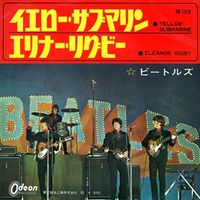
"Eleanor Rigby" is also important in the Beatles' evolution from a pop, live-performance band to a more experimental, studio-oriented band, though the track contains little studio trickery. In a 1967 interview Pete Townshend of the Who commented "I think 'Eleanor Rigby' was a very important musical move forward. It certainly inspired me to write and listen to things in that vein."[20]
Though "Eleanor Rigby" was not the first pop song to deal with death and loneliness, according to Ian MacDonald it "came as quite a shock to pop listeners in 1966."[14] It took a bleak message of depression and desolation, written by a famous pop band, with a sombre, almost funeral-like backing, to the number one spot of the pop charts.[14] The bleak lyrics were not the Beatles' first deviation from love songs, but were some of the most explicit.
In some reference books on classical music, "Eleanor Rigby" is included and considered comparable to art songs (lieder). Howard Goodall said that the Beatles' works are "a stunning roll-call of sublime melodies that perhaps only Mozart can match in European musical history" and that they "almost single-handedly rescued the Western musical system" from the "plague years of the avant-garde". About "Eleanor Rigby", he said it is "an urban version of a tragic ballad in the Dorian mode."[21]
Jerry Leiber said, "The Beatles are second to none in all departments. I don't think there has ever been a better song written than 'Eleanor Rigby.'"[22] In 2004, this song was ranked number 137 on Rolling Stone's list of "The 500 Greatest Songs of All Time".[23]
Historical artefacts
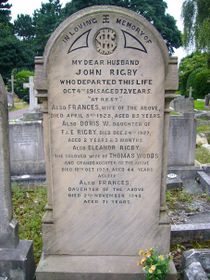
In the 1980s, a grave of an Eleanor Rigby was "discovered" in the graveyard of St. Peter's Parish Church in Woolton, Liverpool, and a few yards away from that, another tombstone with the last name McKenzie scrawled across it.[24][25] During their teenage years, McCartney and Lennon spent time "sunbathing" there, within earshot of where the two had met for the first time during a fete in 1957. Many years later McCartney stated that the strange coincidence between reality and lyric could be a product of his subconscious, rather than being a meaningless fluke.[24] The actual Eleanor Rigby was born in 1895 and lived in Liverpool, possibly in the suburb of Woolton, where she married a man named Thomas Woods. She died on 10 October 1939 at age 44. Whether this Eleanor was the inspiration for the song or not, her tombstone has become a landmark to Beatles fans visiting Liverpool.[26] A digitised version was added to the 1995 music video for the Beatles' reunion song "Free as a Bird".
In June 1990, McCartney donated a document dating from 1911 which had been signed by the 16-year-old Eleanor Rigby to Sunbeams Music Trust,[27] instantly attracting significant international interest from collectors because of the significance and provenance of the document.[28] The nearly 100-year-old document was sold at auction in November 2008 for £115,000 ($250,000).[29] The Daily Telegraph reported that the uncovered document "is a 97-year-old salary register from Liverpool City Hospital." The name E. Rigby is printed on the register, and she is identified as a scullery maid.
Personnel
- Paul McCartney – vocal and harmony vocal
- John Lennon – harmony vocal
- George Harrison – harmony vocal
- Tony Gilbert – violin
- Sidney Sax – violin
- John Sharpe – violin
- Juergen Hess – violin
- Stephen Shingles – viola
- John Underwood – viola
- Derek Simpson – cello
- Norman Jones – cello
- George Martin – producer, string arrangement
- Geoff Emerick – engineer
- Personnel per Ian MacDonald[14]
Cover versions
Studio versions
The following artists have recorded "Eleanor Rigby" in a variety of styles, at least 61 released on albums by one count:[30]
- Doodles Weaver recorded a comedic version for the record Feetlebaum Returns! that was also included on the album Doctor Demento's Delites.
- Vanilla Fudge covered the song on their debut album Vanilla Fudge in 1967.
- Joan Baez's 1967 version, included on her Joan album, was sung to classical orchestration arranged by Peter Schickele.
- P.P. Arnold sang a cover of the song on her album The First Cut – The Immediate Anthology.
- Ray Charles released a version as a single and on the album A Portrait of Ray (1968).
- Bobbie Gentry released a version on her 1968 album Local Gentry.
- Tony Bennett released a version on his January 1970 album Tony Sings the Great Hits of Today!. Bennett was dismayed by having to record contemporary, rock-influenced material under pressure from his record company. His partly-spoken take on the song was poorly received, with music writer Will Friedwald saying it was recited as if it were Thomas Gray's Elegy Written in a Country Churchyard[31] and Time magazine describing it as "Shatneresque",[32] making reference to Star Trek actor William Shatner's 1968 interpretation of "Lucy in the Sky with Diamonds".[33]
- Aretha Franklin released a version on the album This Girl's In Love With You (1970) and as a single.
- Jazz musicians such as The Jazz Crusaders, Wes Montgomery (on his 1967 album A Day in the Life), Stanley Jordan (on the album Magic Touch, 1985) and John Pizzarelli recorded it as an instrumental, with lead-guitar taking over the vocal line.
- Australian band Zoot released a psychedelic rock version in 1970 that reached #4 on the Australian charts and went gold after its 1980 re-release.
- Jamaican musician, singer, songwriter and producer Harris "B.B." Seaton with the band The Gaylads recorded a reggae version of this song in 1972.
- Brazilian composer/singer Caetano Veloso recorded it on the album Qualquer coisa (1975).
- In 1975, Belgo-English progressive rock band Esperanto covered the song on their album Last Tango.
- Wing And A Prayer Fife And Drum Corps recorded this song in their 1976 album Babyface.
- Ethel the Frog covered this song on a single recorded for EMI in 1979.
- The Jerry Garcia Band played an instrumental version as part of a medley with "After Midnight".
- Realm covered this song on their 1988 album Endless War.
- Junior Reid released a dancehall version of the song on his 1990 album One Blood.
- The Violet Burning released this song on their 1992 album, Strength.
- Wayne Johnson recorded an acoustic version of this song for his 1995 acoustic album Kindred Spirits.
- Shirley Bassey covered this song on her 1995 album Sings the Movies.
- Kansas recorded this song on their 1998 album Always Never the Same.
- Godhead recorded this song on their 2001 album 2000 Years of Human Error.
- Pain recorded this song on their 2002 album Nothing Remains the Same.
- Liane Carroll includes a version on her 2005 album Standard Issue
- Thrice included a cover of the song in their album If We Could Only See Us Now in 2005.
- Twisted Sister guitarist Eddie Ojeda recorded a cover version of the song for his 2006 solo album Axes 2 Axes. Dee Snider performed the vocals.
- A cover of the song by David Schommer (feat. David Jensen) can be found on the soundtrack for the 2006 movie Accepted.
- Elevator Suite included a cover in their 2007 self-titled album.
- In 2008, David Cook, winner of the seventh season of American Idol, sang the song on the show and later released a single via iTunes.
- In 1982, Twelfth Night recorded a 80s-style cover of this song for a single, and later included it as one of the bonus tracks on an extended edition of their Fact and Fiction album.
- The John LaBarbera Big Band recorded a version of this song on their CD On the Wild Side.
- Mark Wood released a version of this song on his 2003 album These Are a Few of My Favorite Things with his wife, Laura Kaye, on vocals.
- Ilan Rubin covered this song during his Coup recording sessions and released it as a free download.
- Chick Corea performed a cover of the song on the 1995 GRP tribute album (I Got No Kick Against) Modern Jazz.
- Charlotte Perrelli covered Monica Zetterlund’s Swedish cover, Ellinor Rydholm, on her 2006 album I din röst.
- Father released a cover version in 2009 as a pre-single to their untitled second album.
- Joshua Bell released a cover version on the album At Home With Friends featuring Frankie Moreno.
- Outside Royalty released a cover version on the single "Lightbulb (Turning Off)" in 2009.
- The Ides of March on the album Vehicle as "Symphony for Eleanor." Apart from the lyrics it bears no similarity to the original, but is credited solely to Lennon/McCartney.
- Daze recorded a version of this song on their EP Fresh Red in 2007.
- Talib Kweli & LaToiya Williams released a cover of the song in 2004 entitled "Lonely People" on Kweli's The Beautifil Mix CD
- Michael Lynche covered the song on American Idol and released it as a single. He was the lowest vote getter but was then saved by the four idol judges.
Live performances
- The Four Tops recorded this song for their 1969 album The Four Tops Now!.
- The Supremes recorded this song in a live medley, together with The Temptations.
- Joe Jackson covered the track on his 2000 live album Summer in the City: Live in New York.
- Australian a cappella group The Idea of North sing a jazz version of "Eleanor Rigby" on their Live at the Powerhouse album.
- An electronic version appears on the Tangerine Dream album Dream Encores.
- McCartney performed a live version of "Eleanor Rigby" at Citi Field in July 2009 in which he played acoustic guitar, and the string section was played on keyboard. This version can be found on that concert's recording Good Evening New York City.
Samples
- In 1994, Irish singer Sinéad O'Connor used the lyrics of the song's chorus for her song, "Famine" which appears on Universal Mother. The song was later remixed and released as a single in 1995, and was a Top 40 UK hit.
- In 2004, Brooklyn rapper Talib Kweli released "Lonely People", using "Eleanor Rigby" as the main sample.
- In 2006, mashup artist team9 created a remix of "Eleanor Rigby" using Queens of the Stone Age's "In My Head".
Charts
| Chart (1966) | Peak position |
|---|---|
| UK Singles Chart | 1 |
| Canadian CHUM Chart | 1 |
| US Billboard Hot 100 | 11 |
| Chart (1986) | Peak position |
| UK Singles Chart | 63 |
- UK, starting 11 August 1966: 8-1-1-1-1-3-5-9-18-26-30-33-42
- UK, starting 30 August 1986: 63-81
Notes
- ↑ Miles 1997, p. 281.
- ↑ Beatles Interview Database 2007.
- ↑ Northwich Guardian 2000.
- ↑ RR Auction 2007.
- ↑ Goodman 1984.
- ↑ 6.0 6.1 Turner 1994, pp. 104–105.
- ↑ Time 2010.
- ↑ Harris 2004.
- ↑ Dewhurst 1970.
- ↑ Miles 1997, p. 283.
- ↑ Sheff 2000, p. 139.
- ↑ Miles 1997, p. 284.
- ↑ Miles 1997, p. 282.
- ↑ 14.0 14.1 14.2 14.3 14.4 14.5 MacDonald 2005, pp. 203–205.
- ↑ Sheff 2000, p. 140.
- ↑ Lewisohn 1988, pp. 77, 82.
- ↑ Pollack 1994.
- ↑ Lewisohn 1988, p. 200.
- ↑ Wallgren 1982, p. 48.
- ↑ Wilkerson 2006.
- ↑ Goodall 2010.
- ↑ Swainson 2000, p. 555.
- ↑ Rolling Stone 2007.
- ↑ 24.0 24.1 The Beatles 2000, p. 208.
- ↑ Hill 2007.
- ↑ The Beatles Bible 2008.
- ↑ Sunbeams Trust 2008.
- ↑ Collett-White 2008.
- ↑ Meeja 2008.
- ↑ Clement 2000.
- ↑ Friedwald 1996, p. 397.
- ↑ Tyrangiel 2006.
- ↑ BBC News 2003.
References
- "BEATLES' TRIBUTE TO 'FATHER MCKENZIE'". Northwich Guardian. 9 June 2008. http://archive.northwichguardian.co.uk/2000/6/8/221729.html. Retrieved 15 January 2007.
- The Beatles (2000). The Beatles Anthology. San Francisco: Chronicle Books. ISBN 0-8118-2684-8.
- "Bel Canto & the Beatles". Time. 2 June 1967. http://www.time.com/time/magazine/article/0,9171,902081,00.html. Retrieved 1 May 2010.
- Clement, Ross (27 September 2000). "Beatles Cover List". http://www2.wmin.ac.uk/clemenr/covers/coversfull.html.
- Collett-White, Mike (11 November 2008). "Document with clues to Beatles enigma up for sale". Yahoo News. http://news.yahoo.com/s/nm/20081111/music_nm/us_beatles_rigby_1.
- Dewhurst, Keith (15 April 1970). "The day of the Beatles". guardian.co.uk (London). http://www.guardian.co.uk/thebeatles/story/0,,606241,00.html.
- "Eleanor Rigby clues go for a song". Meeja. 28 November 2008. http://www.meeja.com.au/articles/eleanor-rigby-clues-go-for-a-song. Retrieved 28 October 2008.
- "Eleanor Rigby". The Beatles Bible. 2008. http://www.beatlesbible.com/songs/eleanor-rigby/. Retrieved 12 October 2008.
- Goodall, Howard (2010). "Howard Goodall's 20th Century Greats". http://www.howardgoodall.co.uk/presenting/20centurygts.htm.
- Goodman, Joan (December 1984). "Playboy Interview with Paul McCartney". Playboy.
- Harris, John (20 June 2004). "Revolver, The Beatles". The Observer (London). http://observer.guardian.co.uk/omm/story/0,13887,1240036,00.html.
- Hill, Roger (2007). "Gravestone of an "Eleanor Rigby" in the graveyard of St. Peter's Parish Church in Woolton, Liverpool". http://www.sjsfiles.btinternet.co.uk/rogerrigbyc.htm. Retrieved 9 March 2007.
- "Item 934 - Beatles: Father McKenzie". RR Auction. 2007. http://www.rrauction.com/past_auction_item.cfm?ID=3093601. Retrieved 17 January 2007.
- Lewisohn, Mark (1988). The Beatles Recording Sessions. New York: Harmony Books. ISBN 0-517-57066-1.
- MacDonald, Ian (2005). Revolution in the Head: The Beatles' Records and the Sixties (Second Revised ed.). London: Pimlico (Rand). ISBN 1-844-13828-3.
- Miles, Barry (1997). Paul McCartney: Many Years From Now. New York: Henry Holt & Company. ISBN 0-8050-5249-6.
- Pollack, Alan W. (13 February 1994). "Notes on "Eleanor Rigby"". Notes on ... Series. http://www.icce.rug.nl/~soundscapes/DATABASES/AWP/er.shtml.
- "Revolver: Eleanor Rigby". Beatles Interview Database. 2007. http://www.beatlesinterviews.org/dba07revol.html. Retrieved 9 March 2007.
- "The Rolling Stone 500 Greatest Songs of All Time". Rolling Stone. 2007. http://www.rollingstone.com/news/coverstory/500songs. Retrieved 7 March 2007.
- "Shatner 'breaks' Beatles record". BBC News. 2 May 2003. http://news.bbc.co.uk/2/hi/entertainment/2995901.stm. Retrieved 8 March 2009.
- Sheff, David (2000). All We Are Saying: The Last Major Interview with John Lennon and Yoko Ono. New York: St. Martin's Press. ISBN 0-312-25464-4.
- "Sunbeams dinner and auction". Sunbeams Trust. November 2008. http://www.sunbeamsmusic.org/sunbeams_auction.htm. Retrieved 14 September 2009.
- Swainson, Bill (2000). Encarta Book of Quotations.
- Turner, Steve (2010). A Hard Day's Write: The Stories Behind Every Beatles Song. New York: Harper Paperbacks. ISBN 0-06-084409-4.
- Tyrangiel, Josh (24 July 2006). "Tony Bennett's Guide To Intimacy". Time. http://www.time.com/time/printout/0,8816,1218072,00.html. Retrieved 7 March 2009.
- Wallgren, Mark (1982). The Beatles on Record. New York: Simon & Schuster. ISBN 0-671-45682-2.
- Wilkerson, Mark (2006). Amazing Journey: The Life of Pete Townshend.
External links
- The Eleanor Rigby statue in Liverpool, England
- Eleanor Rigby tombstone photo and info
- Cover version w/Mandolins & Strings
- Manuscript Reveals Clues to Beatles Eleanor Rigby
- Biography of the real Eleanor Rigby
|
||||||||||||||||||||||||||||||||||||||||||||||||||||||||||||||||||||||||||||||||||||||||||||||||||||||||||||||||||||||||||||||||||||||||||||||||||||||||||||||||||||||||||||||||||||||||||||||||||